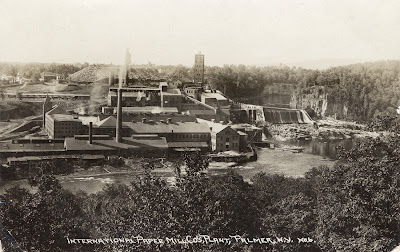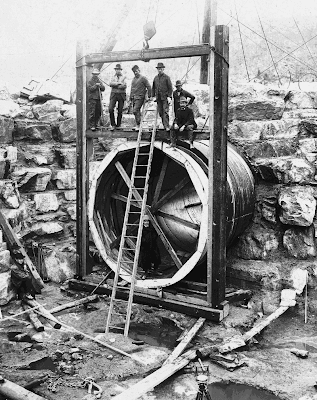 Whether you crave chocolate or relish history, Boscobel has a special event just for you. The early 19th-century house museum on 45 acres in Garrison (Putnam County) swings its gate open for the 2011 season this April 1st, and the entire month promises a variety of unique offerings.
Whether you crave chocolate or relish history, Boscobel has a special event just for you. The early 19th-century house museum on 45 acres in Garrison (Putnam County) swings its gate open for the 2011 season this April 1st, and the entire month promises a variety of unique offerings.
New this year will be special Themed House Tours. In April, think quickly for the April Fool’s: What’s Wrong in This Room? house tours. Join in on the search for off-period items in Boscobel House. Would Elizabeth have one or two sugar cubes in her tea? Did Peter wear a wrist watch on his left or right arm? Careful – Boscobel is trying to fool you. Daily tours throughout the month of April will include a wrong-era object in each room. See the Boscobel website for special themed tours in July & November, too. There is no additional cost for themed tours. (Regular house admission rates apply.)
Eagerly anticipating chocolate from the Easter Bunny? No need to wait that long…come to Boscobel Saturday, April 2 for a luscious lecture and tasting: Wine & Chocolate Pairings with Oliver Kita. According to Chocolatier and Chef Oliver Kita, wine & chocolate are a natural combination. Both have complex flavors and notes, and both have similar components and nuances. Join us for this tasty lecture, and learn how to team up wine and chocolate together in a variety of delicious ways. A sampling of wines and chocolates will be offered. Unique chocolates will also be available for sale, as well as Oliver’s line of “Great Estate Chocolates” which include Boscobel. (Great gifts for Mother’s Day and Easter!) Wine & Chocolate Tasting Plus a Tour of Boscobel House: $35/person at 1pm. Wine & Chocolate Tasting Only: $25/person at 2:30pm. Space limited. Reservations Required. (21 years+) Tickets can be bought online at Boscobel.org. Look for a link on the April event page.
This year’s Seminar Series sponsored by the Friends of Boscobel is titled, “18th & 19th Century Industries in the Hudson Valley.” It all starts April 9 with Ms. Ina Griffin-Guilzon, Museum Teacher at Columbia County Historical Society who will present, “Whaling Industry Based in The Hudson.”
The series will continue on April 16 with Travis Bowman of the NYS Office of Parks, Recreation & Historic Preservation who will give an illustrated talk on “Bobs’ Folly,” how Robert Fulton & Robert Livingston introduced the first steamboat service on the Hudson River.
Finally, on April 23 stop by for: Dr. Tom Carroll, Professor at RPI and associated with “Hudson Mohawk Industrial Gateway” who will give a modified version of “The Hudson as Silicon Valley of the 19th Century” with coverage of the West Point Foundry and Burden Mining near Linlithgo. All lectures are free and do not require reservations- space is limited. House tours are additional.
Are you a garden buff? Rest your spade, and come to Boscobel on Friday April 29 at 2pm for a Garden Tour & Book Signing by the authors of “Gardens of the Hudson Valley.” This stunning, new coffee table book focuses on the Valley’s historic landscape and how gardens have been integrated into it. Photographers Steve Gross and Susan Daly selected twenty-five gardens between Yonkers and Hudson that included famous estates, including Boscobel, as well as private gardens that combine sweeping views and lush plantings. Writers Susan Lowry and Nancy Berner describe each of the gardens in full detail with focus on the history of the site and the strategies for design and plant materials. Join us at Boscobel on Arbor Day where Ms. Lowry and Ms. Berner will lead visitors on a guided garden tour, discuss their book and sign copies purchased in the gift shop. Grounds admission applies.
Due to popular request, Costumed House Tours at Boscobel have been expanded are being offered all day long on the last Friday of every month. Step back in time when Boscobel’s docents dress in period costumes and guide visitors through Boscobel House on an interactive, interpretive tour. They will explain life and times of the 1800s and perhaps share “inside stories” of the Dyckman family. There is no additional cost for costumed tours- regular house admission rates apply.
Live in Orange County? Be sure to visit Boscobel on Sunday, April 17 when it’s Orange County Day. Simply show your proof of Orange residence and your grounds admission is free. It’s a terrific way to discover Boscobel and take in some breathtaking views. Check Boscobel’s website calendar for your free county day.
For a fabulous spring opening sale on many unique home & gift items in the Gift Shop at Boscobel, stop by the first two weeks in April. There’s even a 50% off table sure to please the bargain shopper in you.
For further details on all events and programs, including rain dates & pricing, visit Boscobel.org or call 845.265.3638 after April 1. Boscobel is located on scenic Route 9D in Garrison New York just one mile south of Cold Spring. From April through October, hours are 9:30am to 5pm., the last tour at 4:00pm. The house museum and distinctive Gift Shop at Boscobel are open every day except Tuesdays, May 15, Thanksgiving, and Christmas.
 A guided driving tour of historic dam sites on the Hudson River, organized by the Chapman Historical Museum, will take place on Saturday, August 13, from 9 am to 1 pm. The tour, which will be lead by Jeanne Williams, will include stops in Schuylerville, Mechanicville, Cohoes and Troy. Participants will learn about Victory Mills, the Mechanicville hydroelectric dam built in 1898, the great falls at Cohoes and the Burden Iron Works on the Poestenkill.
A guided driving tour of historic dam sites on the Hudson River, organized by the Chapman Historical Museum, will take place on Saturday, August 13, from 9 am to 1 pm. The tour, which will be lead by Jeanne Williams, will include stops in Schuylerville, Mechanicville, Cohoes and Troy. Participants will learn about Victory Mills, the Mechanicville hydroelectric dam built in 1898, the great falls at Cohoes and the Burden Iron Works on the Poestenkill.







